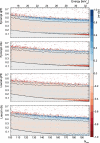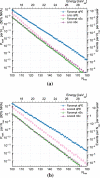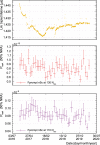Pulse-shape discrimination against low-energy Ar-39 beta decays in liquid argon with 4.5 tonne-years of DEAP-3600 data
- PMID: 34720726
- PMCID: PMC8550104
- DOI: 10.1140/epjc/s10052-021-09514-w
Pulse-shape discrimination against low-energy Ar-39 beta decays in liquid argon with 4.5 tonne-years of DEAP-3600 data
Abstract
The DEAP-3600 detector searches for the scintillation signal from dark matter particles scattering on a 3.3 tonne liquid argon target. The largest background comes from beta decays and is suppressed using pulse-shape discrimination (PSD). We use two types of PSD estimator: the prompt-fraction, which considers the fraction of the scintillation signal in a narrow and a wide time window around the event peak, and the log-likelihood-ratio, which compares the observed photon arrival times to a signal and a background model. We furthermore use two algorithms to determine the number of photons detected at a given time: (1) simply dividing the charge of each PMT pulse by the mean single-photoelectron charge, and (2) a likelihood analysis that considers the probability to detect a certain number of photons at a given time, based on a model for the scintillation pulse shape and for afterpulsing in the light detectors. The prompt-fraction performs approximately as well as the log-likelihood-ratio PSD algorithm if the photon detection times are not biased by detector effects. We explain this result using a model for the information carried by scintillation photons as a function of the time when they are detected.
© The Author(s) 2021.
Figures









References
-
- G. Fiorillo, The liquid argon technology for neutrino and astroparticle detectors, in Dipartimento di Scienze Fisiche Università di Napoli “Federico II” and INFN Sezione di. ed. by In. Nuc, B. Phys, Proc. Sup., (Napoli, Italy, 2006), p. 372–376
-
- C. Gary, S. Kane, M.I. Firestone et al., Large area liquid argon detectors for interrogation systems (2013), p. 698–703
-
- Agostini M, Barnabé-Heider M, Budjáš D, et al. LArGe: active background suppression using argon scintillation for the GERDA -experiment. EPJ C. 2015;75(10):506.
-
- P. DarkSide Collaboration, D Alton Agnes, K. Arisaka et al., DarkSide-50: A WIMP Search with a Two-phase Argon TPC. Physics Procedia 61, 124–129 (2015)
-
- DarkSide-20k Collaboration, C.E. Aalseth, F Acerbi, P Agnes, et al., DarkSide-20k: a 20 Tonne Two-Phase LAr TPC for Direct Dark Matter Detection at LNGS. Eur. Phys. J. Plus 133, 131 (2017). arXiv:1707.08145
LinkOut - more resources
Full Text Sources
Research Materials
